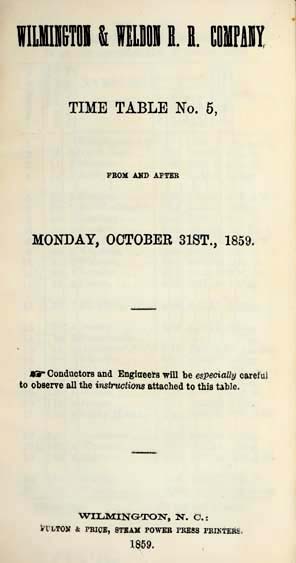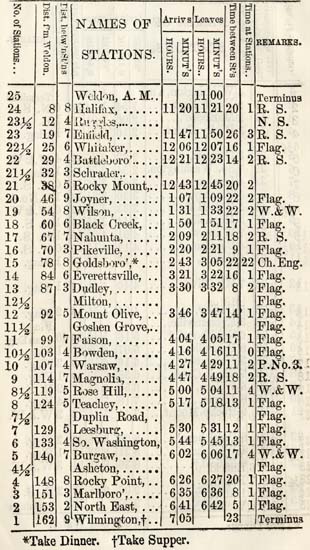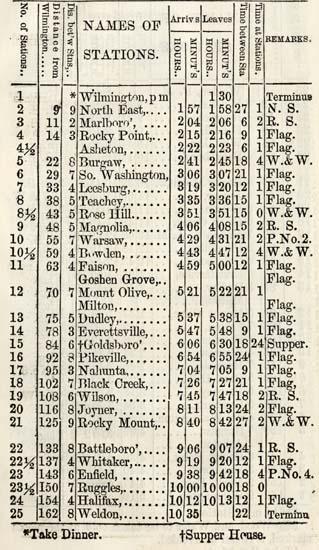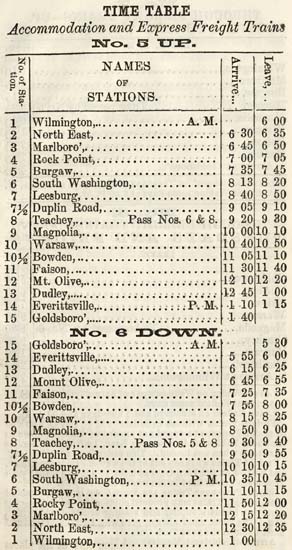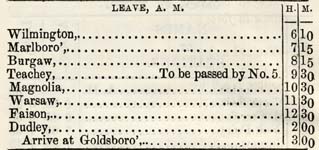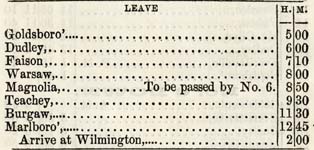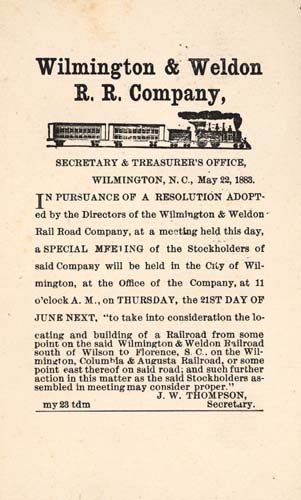Wilmington & Weldon R.R. Company.
Time Table No. 5, From and After Monday, October 31st., 1859:
Electronic Edition.
Wilmington and Weldon Rail Road
Funding from the Institute for Museum and Library Services
supported the electronic publication of this title.
Text transcribed by
Apex Data Services, Inc.
Images scanned by
Elizabeth Wright
Text encoded by
Apex Data Services, Inc. and Natalia Smith
First edition, 2002
ca. 40 K
Academic Affairs Library, UNC-CH
University of North Carolina at Chapel Hill,
2002.
Source Description:
(title page) Wilmington & Weldon R.R. Company. Time Table No. 5, From and After Monday, October 31st., 1859
Wilmington and Weldon Rail Road
12, [1] p.
WILMINGTON, N. C.:
FULTON & PRICE, STEAM POWER PRESS PRINTERS.
1859.
Call number C385.1 W78w (North Carolina Collection, University of North Carolina at Chapel Hill)
The electronic edition is a part of the UNC-CH
digitization project, Documenting the American South.
The text has been entered using double-keying and verified against the original.
The text has been encoded using the
recommendations for Level 4 of the TEI in Libraries Guidelines.
Original grammar, punctuation, and spelling have been preserved. Encountered
typographical errors have been preserved, and appear in red type.
All footnotes are moved to the end of paragraphs in which the reference occurs.
Any hyphens occurring in line breaks have been
removed, and the trailing part of a word has been joined to
the preceding line.
All quotation marks, em dashes and ampersand have been transcribed as
entity references.
All double right and left quotation marks are encoded as " and "
respectively.
All single right and left quotation marks are encoded as ' and ' respectively.
All em dashes are encoded as --
Indentation in lines has not been preserved.
Spell-check and verification made against printed text using Author/Editor (SoftQuad) and Microsoft Word spell check programs.
Library of Congress Subject Headings
Languages Used:
- English
LC Subject Headings:
- Railroads -- North Carolina.
- Wilmington and Weldon Rail Road.
- Railroads -- North Carolina -- Timetables.
Revision History:
- 2003-02-12,
Celine Noel and Wanda Gunther
revised TEIHeader and created catalog record for the electronic edition.
-
2002-05-08,
Natalia Smith, project manager,
finished TEI-conformant encoding and final proofing.
-
2001-11-02,
Melissa Meeks
finished TEI/SGML encoding
- 2001-09-15,
Apex Data Services, Inc.
finished transcribing the text.
[Title Page Image]
WILMINGTON & WELDON R. R. COMPANY
TIME TABLE No. 5,
FROM AND AFTER
MONDAY, OCTOBER 31ST., 1859.
Conductors and Engineers will be especially careful
to observe all the instructions attached to this table.
WILMINGTON, N. C.:
FULTON & PRICE, STEAM POWER PRESS PRINTERS.
1859.
Page [3]
No. 1.
NIGHT EXPRESS TRAIN--NORTH.
To go into operation 31st of October, 1859.
No. 1.
NIGHT EXPRESS TRAIN--NORTH.
* Breakfast.
** Wood and Water.
Page [4]
No. 2
DAY EXPRESS TRAIN--SOUTH.
To go into operation 31st of October, 1859.
No. 2
DAY EXPRESS TRAIN--SOUTH.
* Take Dinner.
** Take Supper.
Page [5]
No. 3.
DAY EXPRESS TRAIN--NORTH.
To go into operation 31st day of October, 1859.
No. 3.
DAY EXPRESS TRAIN--NORTH.
* Take Dinner.
** Supper House.
Page [6]
No. 4.
NIGHT EXPRESS TRAIN--SOUTH.
To go into operation 31st of October, 1859.
No. 4.
NIGHT EXPRESS TRAIN--SOUTH.
* 16½ mile Station.
Wood and Water to be taken only at the places marked, if it can be avoided.
** Take Breakfast.
Page [7]
TIME TABLE
Accommodation and Express Freight Trains
No. 5 UP.
TIME TABLE
Accommodation and Express Freight Trains
No. 5 UP.
Page [8]
NO. 7.
THROUGH FREIGHT TRAINS--UP.
MONDAYS AND THURSDAYS.
NO. 7.
THROUGH FREIGHT TRAINS--UP.
MONDAYS AND THURSDAYS.
Leave Goldsboro' on Tuesdays and Fridays at 5.00 A.M. Arrive at Weldon same days at 5.00 P. M.
NO. 8.
THROUGH FREIGHT TRAINS--DOWN.
TUESDAYS AND FRIDAYS.
NO. 8.
THROUGH FREIGHT TRAINS--DOWN.
TUESDAYS AND FRIDAYS.
Leave Weldon on Wednesdays and Saturdays after 12.00 M. Arrive at Enfield same days.
Leave Enfield on Mondays and Thursdays at 5.00 A. M.
Freight Trains without Schedule will be run as extra or irregular Trains, at a speed not exceeding that laid down in the above Tables, or 11 miles per hour, loaded, and 15 miles per hour when not loaded. This order is imperative.
Freight Trains will keep out of the way of Passenger Trains, and will be on the Turn-Outs at least 10 minutes before such Trains are due at the Station where they may be.
When Passenger Trains are more than one hour behind time, Freight Trains may proceed cautiously--never entering a curve without stopping and sending a man ahead with a flag. The latter must always give way to the former--and must back to the next Turn-Out.
Arrive at Goldsboro', Mondays and Thursdays at 5 P. M.
Page 9
INSTRUCTIONS
To take effect on the 31st day of October, 1859, and continue in force while this Time-Table is current.
1.--Trains 1 and 4 meet at Teachey's. No. 1 having a right to the main track. No. 4 will take the turn-out, whether No. 1 has arrived or not, and will wait 10 minutes; and then proceed cautiously. No. 1 not finding No. 4 at Teachey, will wait 15 minutes, and then proceed cautiously.
2.--Trains No. 2 and No. 3 will meet at Warsaw.-- No. 2. having a right to the main track. No. 3 will wait 15 minutes for No. 2, and then proceed cautiously. No. 2 will wait 10 minutes for No. 3, and then proceed cautiously.
Trains No. 3 and 4 will meet at Enfield. No. 3 having a right to the main track. No. 3 will wait 10 minutes for No. 4 and then proceed cautiously. No. 4 will wait 15 minutes for No. 3 and then proceed cautiously.
Accommodation Trains will wait 30 minutes for Express, and then proceed cautiously.
4.--Any Express Train finding it can not reach a passing Station on time, with the addition of ten minutes,*
* 30 minutes by Accommodation Train.
will go on the next preceding Turn-Out and wait until the passing Train is due at such Turn-Out, by adding 10 minutes to its departing time per table, and then proceed cautiously, olserving all the rules for safety in running, and keeping 10 minutes behind the departing time per table.
5.--Any missing Train will be looked for carefully.-- Take no risks, but always keep 10 minutes behind time until the missing train is met or heard from. Slow running around curves is especially enjoined.
6.--The Whistle will be sounded a few seconds before entering any curve, and 200 yards from all common
Page 10
Road-Crossings--Day and Night. This must not be omitted.
7.--A variation of 5 minutes in arriving at or leaving any Station, will requiure a written statement of the Conductor on his report, and a verbal explanation from the Engineer.
8.--In passing Turn-Outs the speed must not exceed ten miles per hour, and in crossing the Trestle Bridges at Neuse, Nahunta, Swift and Fishing Creeks, and all covered Bridges, the speed must not exceed seven miles per hour. The speed always to be decreased in passing Curves.
9.--An extra Train (and all Trains without schedule are extra,) will be run with the utmost caution around curves, through cuts and over grades, where the track can be seen but a short distance. Head Lights will be shown at Sundown, and earlier if the weather is cloudy or stormy.
10.--No matter how much behind time the trains may be, the Trestles and Bridges must not be passed at a greater speed than seven miles per hour.--Turn-Outs and Stations at ten miles. Conductors must make themselves perfectly familiar with the General Regulations for Running of Trains, together with all the instructions on this Time Table, and the order for Engineers of January 1, 1857, that are now attached to the General Regulations.
11.--When cattle or other obstructions are seen upon the track, the signal for brakes will be given in ample time to check or stop the train, unless the obstruction be so near as to prevent the possibility of reducing the speed before the engine strikes. There can be but little difficulty in reducing the speed to a harmless rate upon this road in the day time, if all the instructions, such as reduced speed around curves, &c., &c., are observed. It will in future be considered an offence to kill cattle, &c.,
Page 11
that will require especial explanation by the Engineer in writing, to the Superintendent.
12.--It is not supposed that the night-train Engineers can so well guard against these accidents after dark, but all possible care must be taken to avoid a collision with animals. If delays occur by these precautions, they must occur. Life and limb, as well as property, must be cared for.
13.--Conductors are responsible for any damage arising from their train hands not being constantly on the platforms near the brakes--one between the two coaches and one between the second-class car and baggage car[.] They will be instructed to lock both brakes as soon as possible: to do so promptly, only a few turns will be given to the first windlass, when the brake-man will jump to the other windlass, and take it up fully, and then return to first one, and set it up more. This will prevent too much force being thrown upon one brake.
14.--Conductors will themselves habitually remain in the last coach, and near the hind end of it, and when the signal for brakes is given on a point of the line where they do not usually stop, they will move promptly to the brake on the hind end of this coach. Conductors will see by constant supervision that the brakes are applied in this way.
15.--Habitually insist that the train shall be stopped in the shortest time possible, and Engineers will then only signal the Brake-men a short distance from the stations, &c. This will save much time in the stoppages.
16.--All Brake-men hereafter found away from their places without orders, when the train is in motion, must be punished properly.
17.--Freight Trains will keep out of the way of Passenger Trains, and will be on a Turn-Out 10 minutes before a Passenger Train is due at such Turn-Out.--They will wait 1 hour and 10 minutes for Passenger
Page 12
Trains after such trains are due, when they may proceed cautiously.
18.--It is to be hoped these orders will be carried out with alacrity and efficiency by all concerned.
EXPLANATIONS.--"R. S." denotes Regular Station--Train always stops. "Flag," stop if Flaged. "W. & W." Wood & Water. "P." pass trains. "N. S." No stoppage.
Passenger Trains change Engines at Goldsboro'.
Lose no time at stations.
Recollect the signal for backing a train is two sounds of the whistle; going ahead three.
Conductors, Baggage Masters and Brakeman, must never go on a train without their Badges.
Accommodation Trains always wait 30 minutes for Express Trains, and never get in the way after dark upon a curve.
S. L. FREMONT,
Eng. & Sup.
Page [13]
Wilmington & Weldon
R. R. Company,
[Illustration]
SECRETARY & TREASURER'S OFFICE,
WILMINGTON, N. C., May 22, 1883.
IN PURSUANCE OF A RESOLUTION ADOPTed by the Directors of the Wilmington & Weldon Rail Road Company, at a meeting held this day, a SPECIAL MEETING of the Stockholders of said Company will be held in the City of Wilmington, at the Office of the Company, at 11 o'clock A. M., on THURSDAY, the 21ST DAY OF JUNE NEXT. "to take into consideration the locating and building of a Railroad from some point on the said Wilmington & Weldon Railroad south of Wilson to Florence, S. C., on the Wilmington, Columbia & Augusta Railroad, or some point east thereof on said road; and such further action in this matter as the said Stockholders assembled in meeting may consider proper."
J. W. THOMPSON,
Secretary.
Return to Menu Page for Time Table No. 5, From and After Monday, October 31st., 1859 by Wilmington and Weldon Rail Road
Return to The North Carolina Experience Home Page
Return to Documenting the American South Home Page

